Intercom

SISTERS OF CHARITY OF CINCINNATI






The Other Side of the Horizon 4-7 Community gathers for Chapter 2023.
Building Futures .................................. 10-11
WIN’s efforts to provide affordable housing.
One Step Closer to Home 12-13
Bethany House Services offers care, community, support and inspiration.
Called to Action 14-16
Sisters and Associates serving the needs of the marginalized.
The Melody of Love
Dear Sisters, Associates and Friends,
Nature has come alive right before our eyes. With summer, it brought everything around us to life, in a full ray of color. It reminds us of all that we have to be grateful for. As the sun and rain nurture all the Earth, we are aware of the human nurturing that takes place in our lives.
In this issue of Intercom, you will read about individual stories, milestone anniversaries, people in ministry, and stories of their journey around mission and their engagement in our communities and our world, each making a difference for the better. Our stories stretch as far north as New Brunswick, Canada, for an in-person assembly of the Sisters of Charity Federation; to the Southwest for an interview with Tomas Sanchez, director of the film about S. Blandina Segale, Servant of God; to the Motherhouse where we gathered together for our 2023 Chapter of Affairs and Elections.
Many of the articles enclosed take a deeper look at the issue of homelessness and affordable housing. In Cincinnati alone, the local lack of housing is forcing families into poverty and homelessness, many of whom are paying two-thirds or more of their income on rent. Volume II of Intercom explores this important subject and how our Sisters and Associates are supporting efforts to ensure that more people have safe, secure, affordable places to live.
Our SC Associates are celebrating their 50th anniversary in 2023. We are in gratitude for the outreach they have given through these past 50 years, making a difference by their ministry, service and prayers, and extending the charism of Elizabeth Ann Seton and the Sisters of Charity.
17
S. Terry Thorman’s friendship with Miss June. A Visit with Associate Pat Schloemer ........ 21 Get to know the Community’s longest living Associate.
Doers of Justice and Makers of Peace 22-24 SC Community forms Justice Circles. Taking the Necessary Steps 25 EarthConnection educates others on the realities of climate change.
St. Joseph Home – The Middle Years 26-28

The many changes and transitions at SJH between 1920-1990.

A Nurturing Spirit ............................... 30-31









S. Jackie Kowalski celebrates 65 years of religious life.


On the Cover: The newly elected Leadership Council of the Sisters of Charity of Cincinnati includes (from left) Sisters Lois Jean Goettke, councilor; Montiel Rosenthal, councilor; Monica Gundler, president; Teresa Marie Laengle, councilor; and Barbara Hagedorn, councilor. Read more on pages 4-7.
Disclaimer: The information contained in Intercom is intended for general information and educational purposes only. Opinions expressed herein are the views of individual authors and do not necessarily reflect the opinions or policies of the Sisters of Charity of Cincinnati.

We have a lot to celebrate, but, most of all, I would like to express the gratitude I have for being able to serve as the president of the Sisters of Charity these last four years. On behalf of myself, and the council, Sisters Joanne Burrows, Teresa Dutcher, Monica Gundler and Marge Kloos, it was our privilege to serve on the Leadership Council. We extend our prayers and support to our newly elected president, S. Monica Gundler, and her council, Sisters Barbara Hagedorn, Lois Jean Goettke, Teresa Marie Laengle and Montiel Rosenthal, for their ‘yes’ to congregational leadership. Blessing to all,
S. Patricia Hayden, SCPlease visit “In Memoriam” at www.srcharitycinti.org for biographical information and reflections on the Sisters of Charity and Associates who have died.


May our Sisters and Associates enjoy the fruits of their labor as well as peace with God.
S. Maureen Donovan
June 26, 2023
Associate Ethel O’Connor
July 20, 2023


Associate Maria Rogers
June 22, 2023
S. Marie Vincentia Roney
June 1, 2023
S. Irene Mraz
April 30, 2023
S. Helen Cranley
April 18, 2023
Associate Eileen Casey
February 19, 2023
Associate Ruth Meyer
January 25, 2023

 By S. Monica Gundler
By S. Monica Gundler
The words seeing clearly, choosing courageously give image to the first in-person meeting of the Sisters of Charity Federation Leadership since 2019. In June more than 70 Sisters were joyfully and enthusiastically welcomed by the Sisters of St. Martha both in Antigonish, Nova Scotia, and Prince Edward Island, Canada. Buses, planes and boats allowed for the celebration and exploration of these beautiful landscapes and those who call it home. The days together included updates from the new NGO representative, Jimmy Walters, and the National Shrine of St. Elizabeth Seton, which is undergoing a significant renovation, as well as sharing from individual congregations, collective ideas, updates from a variety of think tanks, the Federation Vocation/Formation Team and more. The St. Elizabeth Seton Shrine will celebrate a grand reopening in September 2023.
The story of the Sisters of St. Martha includes the journey from the Sisters of Charity of Halifax who originally sent Sisters to Antigonish as Sister-servants in housekeeping for the priests and students at St. Francis Xavier University. Over time a difficult choice was put to the Sisters at a meeting. They were given the choice without talking to one another to stand if they wanted to stay in Antigonish or return to Halifax. Those who stayed became a new congregation called the Sisters of St. Martha. Over time they expanded their ministry to nursing, teaching, social work and becoming ‘jills of all trades,’ spreading out across Canada and into the U.S. Later a separate congregation of Sisters of St. Martha began on Prince Edward Island.
In Antigonish the Sisters have converted their Motherhouse grounds to include a farm co-op for 17 “new growers,” young people trained to become “homemakers of the planet.” The abundance of crops gives a new look to land once occupied by the Sisters. There were tours of the Centennial Gardens that featured significant symbols from the Sisters Motherhouse throughout a beautiful walking path. The last educational post was a mirror inviting those who walked to share in the Sisters desire to care for all creation. In addition, the Sisters also host hiking trails and hermitages as a way of sharing their property. Tours to several other ministry sites, including a safe sober space and Wellsprings listening center, were also on the agenda.
Choosing Courageously was highlighted during a “tea time” sharing in the journey of the Sisters of Our Lady of Mercy from South Carolina as they have vacated and sold their Motherhouse and now discern next steps toward fulfillment.
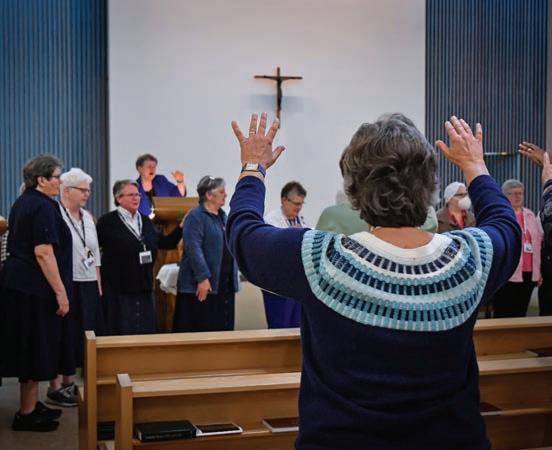
The Sisters of Charity of New York and New Jersey reflected on their experience of sharing a joint assembly or chapter this past year.
There was a report from the Ad Hoc Committee about the future of the House of Charity. After discussion the decision was made for the House of Charity to exist in its current form until completion in June 2024. The Daughters of Charity as owners of the house and property will plan for future use.
The Federation Vocation/Formation team gave updates on their challenges and hopes as this new structure continues to find a way during these emergent times of religious life. In reports from a variety of think tanks several ideas were brought forward including the possibility of another Federation “Gathering of the Whole,” online retreats, and how to best continue to support vocation and formation as a Federation. Shared governance has also been discussed and there will be some members who are willing to work to continue this conversation.
The leaders will meet again during the LCWR annual assembly in Dallas, Texas, and look forward to next year’s gathering in Nazareth, Kentucky. For further information please visit the Sisters of Charity Federation website at www.sistersofcharityfederation.org.






















 By S. Mary Ann Flannery
By S. Mary Ann Flannery




Church law requires religious congregations of Sisters and priests to undertake a review of their government, ministries, life style, prayer life and financial obligations every four years. Elections for central leadership are also held at this time. One might call this gathering a holy time in the history of the congregation which is sanctioned by the Church as ‘Chapter.’
Delegates to the Chapter are presumed to have studied for the meeting and to arrive prepared for debate and discussion guided by professional facilitators. Delegates examine issues and proposals for changes in policy as well as initiatives for new programs and ideas for implementation on how to better serve the people of God.
The Chapter of 2023 for the Sisters of Charity of Cincinnati began the evening of April 16 in the Chapel of the Immaculate Conception with a solemn roll call of 100 delegates each of whom placed her name card in a large bowl. A plaintive flute rendering of Native American music accompanied the roll call as Sisters prayed in silence asking for honesty in facing the challenges of the future of the congregation. S. Mary Ann Humbert felt a strong energy in the room while noting “…that the Sisters took Chapter seriously. We placed ourselves in God’s hands. You could sense we were open, positive, respectful.” Associate Mary Ellen Williams said, “Everyone, both older and younger, seemed committed to sum up the courage to forge ahead with faithfilled togetherness and communal wisdom.”
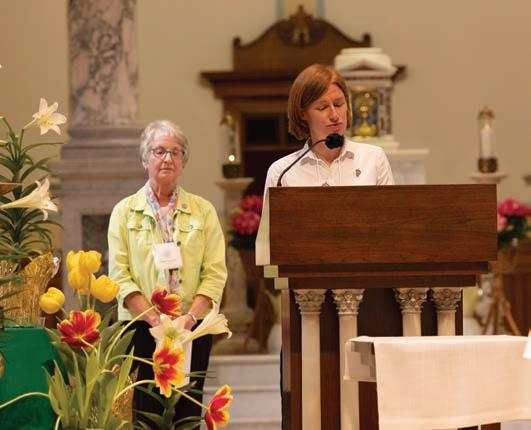

Without a doubt, a year-long preparation for Chapter fostered its profound, positive effect, the result of a Chapter Planning Committee’s work through members, Sisters Barbara Hagedorn, Carol Wirtz, Katharine Pinto, Marge Kloos, Monica Gundler, and Annie Klapheke with input from facilitators, Debbie Asberry and Lisa Negstad. Small group meetings were held throughout the year for the Community to discuss ideas, concerns, and issues for refinement into Chapter proposals and statements.
The week’s work began with Debbie Asberry’s presentation on the Adaptive Landscape, a strategic movement designed to help an organization in a time of uncertainty toward a “… radical pursuit of what is possible.” The landscape diagram helped us see how we can move from certainty (what will happen) to agreement (what is to happen) as we handle challenges that are often chaotic or frightening but must be examined. Such concerns escalate from the practical involving the dismantling of buildings, the liquidation of properties, to the spiritual and relational life such as nurturing of friendship and respect in community, evolution of new ministries and forms of assisting in past ministries and sponsorships. As pointed out by the facilitators, these topics generate questions that could confound many of us but we have to overcome whatever impasse we are sure to encounter in order to move through the landscape and arrive at acceptable direction and answers. S. Christine Rody commented that given these complexities, and the weight of each decision which can be held up by an impasse, she appreciated being told, “The only way forward out of an impasse is to keep asking the questions until we reach the key question.”
Sisters Louise Lears, Andrea Koverman, and Marge Kloos were asked to be the Listening Team charged with distilling what they heard and saw from the discussions every day. In addition, they studied the writings posted on newsprint which emerged from group discussions. It was important to tease out the meanings at the heart of these conversations which the committee then highlighted under parts of our Chapter Prayer. The resulting document, titled SC Horizon, outlines what is possible with freedom, dreams, heart, and the grace of the Holy Spirit. As one of the Chapter planners, S. Annie Klapheke, said, “I learned that our Community is ready and poised to embrace our emerging present and future” and that “leaning into emergence and uncertainty is, in fact, what religious have always done.” She thought there was a synchronicity between Chapter Planning and what the Listening Committee surfaced, the result of the Spirit working within and among us. S. Louise affirmed the work of the Listening Committee saying, “You (Community) affirmed, unanimously, that our SC Horizon rings true to our experience and becomes our Chapter Direction.”


Asberry and Negstad kept the sails of the Chapter on course with reflective questions like, “How are we being invited into a new consciousness? How am I called to stand apart from the dominant culture and those in power such as in the Church and the government?” The story of Jesus and the Woman at the Well became a starting point to meditate on ‘letting go and letting come,’ the “unfolding evolution” of Jesus and the woman’s dialogue on “authentic” faith. S. Whitney Schieltz could not have said it better for all of us while we pondered these questions. “Being one of the newest and youngest members of the Community, I’ve had a unique experience of religious life that I think offers a valuable lens through which to envision the emerging future of our Community as well as the evolution of religious life as a whole.” Whitney thought it was important to add her voice participating in our Community’s unfolding story and “listen deeply to my Sisters and be attentive to the Spirit within and among us.” S. Pat Wittberg would agree adding we have always listened to our prophets who took us from the pattern of the Organized Landscape toward the Adaptive Landscape; we have, indeed, been blest.











Discernment for election began Wednesday afternoon as desert time in which Sisters engaged in personal private prayer and ate dinner in silence. Discernment continued the following day as nominated candidates were invited to discuss with the delegates whatever topics the delegates brought to the floor. In the afternoon, candidates formed a panel and continued their discussion on what concerned delegates. The day ended with a deeply moving Taize prayer in the chapel.
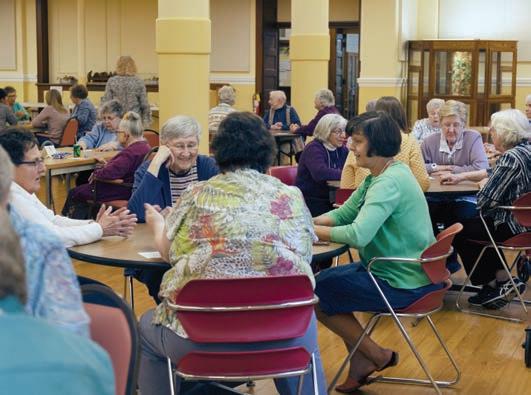
Elections are never an easy moment in any Community’s history. Candidates have to be willing to surrender personal attachment to their current ministry and sometimes to relocate for proximity to the team and the heart of the community, Cincinnati. Our newly elected leaders are:




















S. Monica Gundler, president, who will serve four years with council members, Sisters Barbara Hagedorn, Lois Jean Goettke, Teresa Marie Laengle, and Montiel Rosenthal.
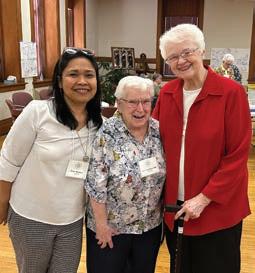


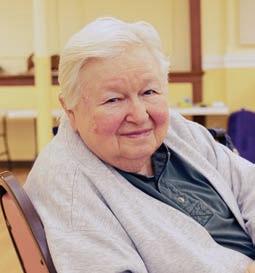





The Sisters who completed their time in leadership are: S. Patricia Hayden, president, and her council, Sisters Joanne Burrows, Monica Gundler, Marge Kloos and Terry Dutcher. As a Community we owe gratitude for what has been done in the past leadership, and we say ‘yes’ for what is to come through our new leaders. Chapter 2023 now forges ahead with an excitement for the future, a deep commitment to the needs of others and a loving joy of being part of our Community in this unfolding mystery of God’s love.

 S. Donna Bryant
Discussion in small groups took place in the Motherhouse chapel. (From left) Sisters Mary Fran Davisson, Mary Ann Humbert and Mary Alice Stein.
S. Patmarie Bernard
Sisters gathered in their cohorts for group photos.
(From left) Sisters Romina Sapinoso, Kathryn Ann Connelly and Mary Jo Gasdorf
S. Pat Hayden opened the Chapter on Sunday, April 16, 2023.
S. Donna Bryant
Discussion in small groups took place in the Motherhouse chapel. (From left) Sisters Mary Fran Davisson, Mary Ann Humbert and Mary Alice Stein.
S. Patmarie Bernard
Sisters gathered in their cohorts for group photos.
(From left) Sisters Romina Sapinoso, Kathryn Ann Connelly and Mary Jo Gasdorf
S. Pat Hayden opened the Chapter on Sunday, April 16, 2023.
Associates Angela Anno and Beth Rohan made their commitments as Associates in Mission on Wednesday, April 19 in the Motherhouse chapel with the support of many Sisters and Associates.
























On Thursday, April 20, delegates were joined by Sisters and Associates in a Taize evening prayer in the Motherhouse chapel which consisted of song, voice, violin, cello, piano and quiet meditation.
Associates closed their time at Chapter with all Associates and collaborating Sisters gathering in a circle and sharing their feelings about the Chapter experience. They sang “Ubi Caritas,” and repeated a ritual sharing of peace.




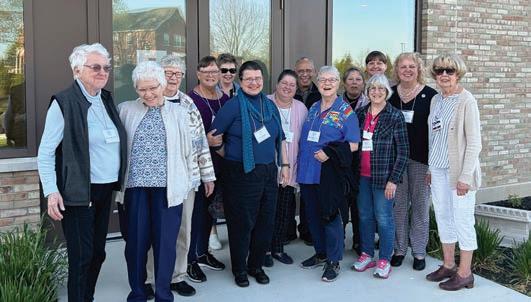



 Sisters and Associates were given a tour of the new La Casa del Sol Ministry Center.
S. Peggy Deneweth
Associate Angela Anno celebrated her commitment as an Associate in Mission on Wednesday of Chapter.
S. Donna Bryant
Sisters and Associates were given a tour of the new La Casa del Sol Ministry Center.
S. Peggy Deneweth
Associate Angela Anno celebrated her commitment as an Associate in Mission on Wednesday of Chapter.
S. Donna Bryant
Fifty or 75 years ago, when our parents or grandparents were planning to buy a house, they faced a much different housing market than young people do today. Post-war government programs subsidized the expansion of new suburban areas, and new construction techniques enabled local builders to provide homes that were easily affordable to middle-class couples. The average house sold for little more than what the husband of the family made in a year, and government-backed mortgages were easily available. It was easier and cheaper to buy a house than to rent one. If you were white, that is: FHA- and VA-backed mortgages that made this possible were not available to African Americans, and the suburbs were redlined against them.
Things began to change in the 1980s and 1990s. Local builders were replaced by large house-building corporations that operated nationwide. These companies competed to make the most money they could, and they received greater profits per house if they built large houses than if they made smaller ones. So the size, and the cost, of houses increased. At the same time, local banks and savings and loans were being replaced in the housing market by large, national banks. These banks loaned their mortgage money, not one house at a time, but by quickly lumping together loans for thousands of homes and then selling “securities” – slices of this lump – to investors. The more loans the banks made, the more securities they could sell. Neither the banks nor the investors had any incentive to check whether the families could actually afford the houses they were being coaxed to buy. And many couldn’t. In 2008, therefore, the housing market collapsed. Millions of over-mortgaged families lost their homes. Housing values fell. Minorities, who had only recently been allowed into the housing market, were the hardest hit. Black household wealth,
much of it dependent on home values, fell by almost 50 percent when they lost their homes and had to rent again. Today, the average wealth of Black households is less than $10,000, while the average wealth of White households is $171,700.
After the 2008 housing market collapse, outside investors began to realize that they could make a lot of money by buying up homes and “flipping” them to rental properties. Today in some cities, as many as 40 percent of the houses that go on sale in a given year are bought by outside corporations, who pay for them in cash and turn them to rentals. In Cincinnati, the three largest out-of-town investors have bought and flipped more than 4,000 houses. And these are just the three largest: there are more than such 20 investors operating here. Still other investors buy up dozens or hundreds of apartment buildings, neglect maintenance, and raise the rents. One such investor owns more than 300 apartments in East Price Hill alone. HOUSING IS A
HUMAN RIGHT.
LACK OF AFFORDABLE HOUSING AFFECTS THE MENTAL AND PHYSICAL HEALTHOF FAMILIES.
TOUS, T H EY IMAG E JE SUS, W HOALSO
“HAD NOWHERE TOLAY HIS HEAD.”
This “financialization” of housing has had several really bad effects:
• Young couples, or any first-time home buyer, can’t compete with outside corporations who can pay the entire price upfront. So they end up staying renters. Cincinnati has the second-lowest homeownership rate in the country.
• Extra renters looking for apartments, and out-of-state investors buying apartment buildings, cause rents to rise. Last year Cincinnati had the highest yearly percentage rent increase of any city in the entire United States. Rents increased 17 percent between 2020 and 2021, and another 22 percent between 2021 and 2022.
• The poorest families suffer the most. An affordable rent or mortgage is supposed to be 30 percent of a family’s income, but only a fraction of the available apartments are affordable to the poorest families. Nationwide, over threefourths of the poorest families spend more than half their income for rent and utilities, skimping on food, medical care, and other necessities as a result. It takes only one mishap – a child gets sick, the car breaks down, a partner becomes abusive – and when the next month’s rent comes due, there is no money to pay it and the family is evicted. The national average for the amount of money a family needs to avoid eviction is $350. Legal Aid lawyers working on eviction cases in Ohio are overwhelmed and can’t contest even blatantly illegal evictions. In Cincinnati, Legal Aid can only represent 3 percent of eviction cases: the lowest percentage in the entire country.
• Homelessness increases. In central Ohio and Columbus, homelessness rose 20 percent last year. The city’s shelters are full, and many have a waiting list. The primary cause of homelessness in the United States is the shortage of affordable housing.
What can we do to help address the affordable housing crisis? The director of Price Hill Will has a few suggestions for Ohio residents:
• State Senator Bill Blessing is sponsoring several bills on this issue: one that will tax outside investors who are buying and flipping houses, and another that will require landlords to accept rent in cash since many of the poorest tenants do not have bank accounts. We can contact his office to inquire about the status of these bills and support his efforts.
• The Cincinnati City Council is suing VineBrook Homes, an out-of-state investor that has flipped hundreds of homes. But lawsuits like this take money and staff time. We can contact council members and stress how important these lawsuits are, so that they are not tempted to re-allocate the funds for them elsewhere.
• One reason so many out-of-state investors come here is that Cincinnati has a past reputation for being easy on landlords. The city has a Rental Property Inspection Ordinance requiring the compilation of a database of all rental properties so that the city can inspect them. But this database is out of date and incomplete. Additional funding and staffing would be needed to revise it. Landlords are also allowed to get away with not following city laws. They are not supposed to discriminate against tenants with Section 8 housing vouchers, but many do. They are required to accept partial payments if a tenant is trying to avoid eviction, but many don’t. The city often does not, or cannot, follow up on these violations. We could support the groups like the Greater Cincinnati Homelessness Coalition and Legal Aid in their efforts to increase the enforcement of these laws.
Housing is a human right. Lack of affordable housing affects the mental and physical health of families who, despite working hard and long at minimum wage jobs or relying on Social Security payments because of age or disability, still have to spend 50 percent, 60 percent, 75 percent or more of their income on rent. To us, they image Jesus, who also “had nowhere to lay his head.”
In an article printed in the 2020 issue of Intercom, we spotlighted the work of Working In Neighborhoods, a nonprofit organization formed to help low- and moderate-income residents in Cincinnati’s neighborhoods. Executive Director and Sister of Charity Barbara Busch cofounded WIN and has worked for more than 40 years to help residents shape their communities. With her knowledge and experience in the field of affordable housing, S. Barbara has become a wisdom figure and leading authority for the city of Cincinnati and beyond. Her guidance and forethought are empowering families and growing communities.
Three years ago, WIN embarked on its Net Zero Urban Village project in the small AfricanAmerican, low-income community of South Cumminsville (Cincinnati). The project includes 50 near net-zero homes – rehabbing 25 existing homes for senior homeowners to improve energy efficiency and building 25 near net-zero homes to incorporate alternative energy technologies. The goal is to provide safe, secure and affordable housing. “By making energy bills more affordable, homes are more affordable,” says S. Barbara. “If we can keep those bills down, it helps families over the long haul to be able to stay in their home. A second reason is we feel that this is something we should be doing for the Earth and for low-income communities who don’t normally get experience with any new kind of technology. When our kids grow up they don’t know about new technology and they can’t use that as a choice for a job. Our goal is to spread information in our communities and give people an opportunity to see what’s possible and what will be our future.”
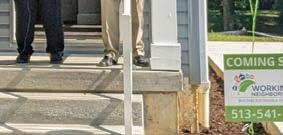



Many residents in the neighborhood lost their homes during the recession and foreclosure crisis. The net-zero houses being built will go in spots where there were homes and where there were families; the goal being to bring families back to the community. This innovative solution took hold after thoughtful planning and discussion with the community. S. Barbara then gathered energy experts to talk the organization through the process of making the homes energy-efficient.
WIN has completed 15 energy retrofits for senior homeowners with the thought that they would help them stay

in their homes, and provide for the next generation. “[The house] always goes to the family,” she said. “What we saw during the recession, when homes aren’t in good shape and you pass those on, they aren’t necessarily something people can keep.”
Success stories abound. Prior to putting in new windows and weatherizing a home, one resident could only live in one room of her house and wore a winter coat most of the time. One of the first things she told S. Barbara after the remodeling is that she could use her whole house now. She can have people over and sit in her living room. She also never realized how much noise there was. Now that the house is sealed, she is able to sleep through the night. “Giving people the opportunity to be able to use their home the way they’d love to is extremely important,” says S. Barbara.
Another resident didn’t have air in her upstairs. WIN installed new, energy-efficient windows and put in a new heating/cooling and hot water system. Prior to the additions the whole family would sleep on the first floor of the home where the window unit was. Results were seen and felt immediately. Once the whole family could go back upstairs to their rooms to sleep, the homeowner told S. Barbara her teenage son was able to perform better at work because he was
finally sleeping in his bed and not on the floor. The slightest changes and additions make a world of difference for families.
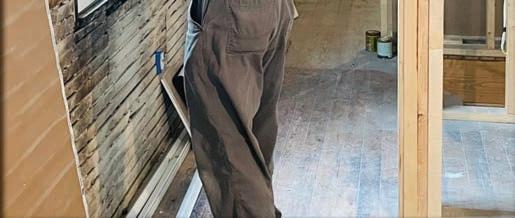
Funding for the Net Zero Urban Village has been a challenge. However, WIN has assembled funders to pay for the construction of the first seven net-zero homes. The organization is breaking ground on the first two homes this summer. WIN continues to seek investments for this innovative approach to reinvigorating the housing stock in South Cumminsville.







WIN’s vision for empowering families and communities extends to the entire county. In one of its latest efforts, WIN has partnered with The Port of Greater Cincinnati Development Authority, a quasi-governmental organization whose purpose is to create equitable economic development in the Cincinnati metropolitan area. The Port, as it’s called, bought from a bankruptcy sale, 194 single-family homes that are rentals. WIN’s part is to help families in those homes become homeowners. S. Barbara says, “This is important because when out-of-town investors buy up our singlefamily housing stock, they are taking away the opportunity for people to buy their first home, particularly low-income, working-class folks. From our perspective it’s a way to help those families already in these homes to buy their home and The Port will fix up the homes so that they are in good condition.”

WIN has been instrumental in this process helping residents to prepare for homeownership. Though it may take years before some are ready, the long-term goal is to help families and neighborhoods become stable by getting people to participate in the system as much as they can. “People ask if we give away homes; we don’t give away homes,” S. Barbara says, “we help families get bankable. At WIN we want people (whether they buy a home or whether they just get their finances in order) to be in a position where they can do what they want to do with the money they have and know they have choices. We provide the services to help families empower themselves. If we teach parents, they will teach their children. We are now seeing second generations purchase homes.”


“We want everyone to be in good shape,” adds S. Barbara. “These folks never thought they had a chance. They didn’t start saving money nor had a large income to start with; landlords kept raising their rent, so the money they did have went right to rent.” The Port is keeping rent low and selling houses at a lower amount so it’s possible for families to purchase homes. And, if they don’t want to own a home, they will be in a better place to rent. With the help of WIN and The Port, families will have the ability to make the choices that are best for them.
S. Barbara and her staff of 18 at WIN believe that housing is key to opportunity. Through its financial literacy training, community building and housing development, WIN will not stop working to better communities and educate residents to improve their lives and the neighborhoods they live in. Research shows that homeownership improves health and education outcomes, community safety and stability. “That’s what we want for every family,” says S. Barbara, “opportunity for themselves and for their children and for the generations that follow them. That’s why we do what we do.”
It was the summer of 1983 and the Sisters of Charity had experienced a spring Chapter where preparation and discussions centered on how can we more truly journey with the poor and risk actions that will effect justice. Together we prayed that the flow of God’s work would find an opening in us. S. Mary Grafe was working at Peaslee Neighborhood Center among the poor, asking how to serve the unmet needs of mothers and children without a home. S. Dee Sizler was aware of homelessness among single women and witnessed the poverty of families and their lack of services, asking: Can we collaborate with other existing groups to effect change? It was as if the parable of the sower and the seed was catching hold as the seed fell on ‘good ground.’ Both women were spurred on by the Acts of Chapter 1983 “to know the needs of our sisters and brothers and to dare to risk a caring response.”

From this impetus by the SC Community and their ready supporters, Bethany House was birthed into being. The early founding group gathered from a variety of faith backgrounds, all bringing energy for action. They brought a heart for mothers and children needing a home. Barbara Poppe called the partners together; Harold Dreibelbis provided financial expertise; Becky Johnson summoned contributors; Church of Our Savior and Church Women United joined in. It was with
the help of the Franciscan Friars, Province of St. John the Baptist, who owned the house, and so many committed supporters, that this house of hospitality came into existence. Bethany House opened in 1983 with S. Dee as the first director. They welcomed at-risk families and homeless mothers and children with a mission to find solutions to achieve housing stability. Their shared vision was to live in a community where all families have a place to call home and no one spends a night without shelter.
Over the founding years new partners joined the effort; in 1985, Mercy Sister Mary Stanton became the director and the Homeless Coalition was formed.

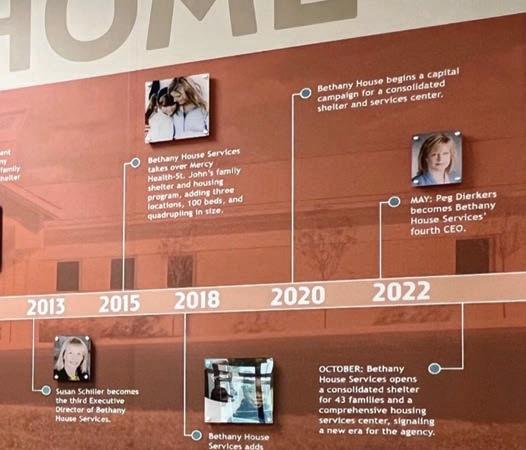

Increased demands called for more beds, homes were added and eventually more services were provided thus changing their name to Bethany House Services (BHS). In 2000, they collaborated with the Hamilton County Department of Human Services and others to form the Family Shelter Partnership Program. This addition and emerging grants enabled Bethany House to add permanent housing services.

In 2013, Susan Schiller became the first lay leader and third generation of leaders. She was relentless in seeking additional mental health services for the organization. By 2018 they were in five locations, providing 100 beds. In 2020, they began a capital campaign for a consolidated shelter and services center.


In the fall of 2022, a new era for the agency began. BHS welcomed Peg Dierkers as the fourth CEO and Carolyn Washburn as Board chair. In a year of transformation they raised $20 million and opened a modern, consolidated, community-style facility enabling Bethany House Services to enhance efficiency and maximize resources. All services are on one site. Guests have their own rooms and the dignity and privacy that offers. They are ensuring that all families have access to the services and care needed, offering 43 private family bedrooms and space for children to play, learn, grow and thrive. S. Dee is most proud of the directors and dedicated Board members who have kept BHS together, moving forward, particularly past director Susan Schiller.

In an interview with guest Carrie it was apparent that she was making the best of her time at BHS, participating in life skills classes, and working with her case manager on completing all the necessary steps to find housing. Carrie and her 20-year-old son Matthew had been at Bethany for almost 200 days; their situation is not typical. Matthew is disabled and the family has a dog, Max, who is currently being cared for by another local shelter. Staff went the extra mile with her; these were unique barriers that Carrie has had to work through before she was able to get housing. Her advice to others: “Be open to help; it’s here! Don’t give up. Develop a schedule, learn to be organized and follow a budget. Then a home and job can follow.”
The new BHS setting is ensuring that all families have access to the services and care needed. The leadership team has welcomed the potential opportunities with enthusiasm. Adult education, mentorship programs, support groups and counseling are offered on-site. Other services include medical and mental health that are often obstacles to a stable environment. Service providers are empowering parents and children through guidance and tools for parents along with academic, social, emotional and therapeutic children’s activities. During this initial year BHS has offered more than 50,572 bed nights in shelter for 251 families. A typical stay is 39-45 days. The programming and services for guests is showing promising results so far. Eighty-six percent of the families who graduated from the program have not returned and 82 percent have remained housed. Current Board member Sister of Charity Lynn Heper pointed out another professional benefit. “These social workers, case workers and support staff all come to the same facility now, not five different locations. They serve, interact and support one another professionally. This results in a wealth of knowledge, techniques and shared skills to make a real difference for guests and themselves. It’s a win for all.”
What’s next? As Bethany House Services takes time to celebrate its 40th anniversary this October, the organization sees a need to further develop childcare on-site and increase the number of outside providers. In an interview with current Board Chair Carolyn Washburn they are not resting. As past editor of the Cincinnati Enquirer (until 2015) she was aware of the helplessness experienced around children and poverty in the Cincinnati community. She wanted to find ways to help people better understand their priorities as voters and committed citizens. Both Carolyn and her husband volunteered initially at BHS with dinners and childcare; she was very impressed with the organization. Soon she agreed to serve on the development committee and eventually the executive committee, offering gifts from her valuable connections in the Cincinnati community. Carolyn is moved by the potential in the women and children BHS is serving; she doesn’t want to lose these important benefits for the community.
Now, in 2023, with the new facility functioning, the Board and leadership feel ready to embark on the new strategic plan. They are asking how the Cincinnati community needs Bethany House Services next. The Board would like to see those who have been nurtured from services received at BHS to become more visible, to find ways for the community to get to know their families. Carolyn shared, “We need to continue to tell their story and their value as persons and as citizens in the community.”
All interviewed for this article expressed the significant importance of keeping the issue of affordable housing in the forefront. All will stay committed and keep the pressure on for housing to receive the attention it deserves. Thanks to the believers in Bethany House, past and present, Cincinnati families are one step closer to home.

“To speak the joy of my soul at the prospect of being able to assist the poor … and teach them to love God.”
Today these inspirational and motivational words from Elizabeth Seton dwell in the hearts of her followers and impel them to action. There is no negligible help in serving the poor, the homeless, the addicted. Every caring word, action, smile is monumental to the receiver. Several Sisters of Charity of Cincinnati and Associates, “urged by the Charity of Christ,” are serving the needs of many marginalized people of God. Some through retreats for those recovering from addiction, some with organized agencies, and some with recycled plastic bags and a truck!
The Ignatian Spirituality Project (ISP) retreats were begun by Bill Creed, SJ, and Ed Shurna in Chicago, Illinois, to offer experiences of hope, healing and belonging to those recovering from homelessness and addiction. In 2009, Bill met with S. Donna Steffen and several others from the Jesuit Renewal Center to begin ISP for women in Cincinnati. S. Donna continues today in Cincinnati with current team members, Sisters Annie Klapheke, Maureen Heverin, Martha Walsh and Associate Anne Shaffer. S. Martha was invited to participate in one of the weekend retreats and at its conclusion she said, “I was invited to join the team and have been gratified to be part of it. This program is one where one receives while at the same time sharing and giving.”
Thirteen years ago, S. Teresa Marie Laengle began ISP in Dayton. “I fought with God for six months because I felt I didn’t know anything about relating to women who had been homeless, were in jail, had been abused and were drug or alcohol addicts,” she recalls. S. Teresa reached out to the ISP National Office for assistance. She invited women to help her, contacted recovery shelters, located a retreat facility, and wrote grants for money.
Today, Allison Loecke, regional representative from the Chicago National Office, coordinates the retreats in five cities, provides an agenda, Zooms in on meetings, assists ISP retreat leaders with materials and funding needed for the retreats. S. Donna describes her ISP participation: “I find that I am a learner with these women. They have had difficult experiences that I will never have. I may talk about ‘surrendering to God.’ These women have surrendered.”
ISP women retreatants come from several recovery centers and are required to be working a 12-step program, AA or NA (Narcotics Anonymous), and be in recovery for 30-plus days. The retreat format is based on the 12 Steps of Alcoholics Anonymous (AA) and the Spiritual Exercises of St. Ignatius of Loyola. There are overnight retreats in facilities apart from the shelters (Transfiguration Retreat Center in Glendale, Ohio and Bergamo Retreat Center in Dayton, Ohio) and

post-retreat evenings or days of reflection at the shelters. The overnight retreats are facilitated by a four-member team and include group sharing, learning different ways of praying, and witness talks from previous participants. The women receive a hand-knitted shawl, a journal and toiletries gift bag. A comment spoken to Anne Shaffer on one of the retreats was “how we accept them without judging, she seemed to be amazed at that, but then these women are judged all the time.”
ISP challenges include losing a former participant to overdosing or death, women experiencing difficulty during the retreat, hearing painful stories, planning for and wondering who will come, and transportation issues. S. Teresa comments, “We have come to the conclusion that whoever shows up was meant to be there.” Significantly greater are the celebrations, including expressed gratitude from the women, retreatants involvement in follow-up reflections and witness talks, hearing success stories, and continuing contact with participants after the retreat. One woman expressed to S. Maureen, “great gratitude to God and all who have been God’s messengers.”
Contemplating the challenges and celebrations S. Annie states, “The ultimate goal is for the women to grow in closer relationship with their Higher Power/God, and to know that they are loved and valued.”


“The vision of St. Vincent is to embrace the world in a network of Charity.” - Frederic Ozanam

The mission of the St. Vincent de Paul (SVdP) Society is “a network of friends, inspired by Gospel values, growing in holiness and building a more just world through personal relationships with service to people in need.” Faithful to the spirit of Saints Elizabeth Seton and Vincent de Paul, several Sisters and Associates volunteer with the St. Vincent de Paul Society. Some Charity Sisters and Associates work out of parish SVdP conferences: Sisters Patricia Wittberg, Holy Family; Patrick Ann O’Connor, St. Dominic; and Associates Carol Herbert, St. William; and Debbie Weber, Guardian Angels. Each woman responded to an individual call to this ministry to provide food, shelter, medicine, prayer and friendship to the poor in their community.
Carol retired after 40 years of serving families from St. William parish. She began with a basement closet food pantry that expanded to a modular extension of the school building. Mary Beth Gramman, current president for St. William SVdP Conference, says, “For us, Carol has been the face of St. Vincent de Paul in the community. She has been our guide and mentor.” Carol states, “God directs everything in my life … when I hear someone say, ‘thank you, Jesus,’ they get it. It is not us helping, it is the love of Jesus.”
Debbie Weber was invited, motivated and inspired by her daughter to help assemble bags of food and toiletries, distribute vouchers for clothing and furniture and Kroger gift cards for needy people within Guardian Angels parish. She values talking with these neighbors, cherishing their stories and keeping them in prayers. Debbie says, “I am humbled to be able to serve my sisters and brothers alongside my daughter.”
While teaching in Indianapolis, Indiana, S. Pat Wittberg volunteered on Saturdays at a SVdP warehouse distributing furniture and clothing. When she retired and moved back to Cincinnati in 2015, S. Pat continued this ministry on a





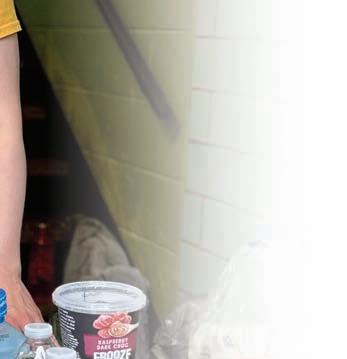


 S. Donna Steffen (right) and Associate Anne Shaffer (second row, left) are two of the current Ignatian Spirituality Project retreat team members in Cincinnati.
S. Donna Steffen (right) and Associate Anne Shaffer (second row, left) are two of the current Ignatian Spirituality Project retreat team members in Cincinnati.
different level. Father Wenke, pastor of Holy Family, called S. Pat and others to revive the SVdP conference in the parish. This was just in time! In 2020 there was a huge apartment fire blocks away from Holy Family. Eight immigrant families in the parish lost everything and the Vincentians responded with beneficial help. The need continues in this area with at least 15-20 requests per week for help with rent, utilities, food, furniture and clothing. S. Pat remembers many of the people SVdP helped and cherishes their stories, “I just feel so good when we are able to help some of these people.”
S. Patrick Ann, while still working, is a valuable behindthe-scenes volunteer with St. Dominic’s SVdP Conference. She attends and begins the prayer session for the bi-weekly meetings to make difficult decisions regarding who qualifies for assistance. She is in charge of collecting boxes, the important logistic element for food delivery! “I feel this is not a huge help but those who fill and distribute the boxes are grateful that I take care of this item,” she says.
After finishing her term in leadership, S. Christine Rody responded to the need for a Spanish translator to help register clients at the SVdP charitable pharmacy at the Neyer Outreach Center. S. Chris also translates for pharmacy students while they perform clinical services for clients including blood pressure, medication and diabetes checks and vaccinations. She calls people, in English and Spanish, to remind them of appointments and needed documents. “It’s a very peoplecentered service that is of great help to folks!” she adds.

All these SC Vincentians face challenges of limited funds and volunteers to fulfill the needs of God’s poor. All celebrate the appreciation from and shared prayer with their less fortunate neighbors.
“Listen to the cry of the earth and the cry of the poor, who suffer most.” - Pope Francis
In Spring Hill, Florida, SC Associates* resolved to help the homeless and at the same time save the Earth by recycling
plastic bags. Associate Theresia Griffin invited a group of Associates to engage in a project to crochet mats and pillows out of plastic bags that could offer some physical comfort for the homeless. Plastic bags were collected from stores, families, neighbors and friends. Gail Metcalf’s neighbors, with SC Associates and Candidates, worked many hours collecting, folding, cutting, rolling into balls thousands of plastic bags for others to crochet. Gail is called the “bag lady” in her community! Theresia and Iris Ramirez crochet the plastic into mats and pillows and Associate Geri Anderson crochets lap blankets from donated yarn. Gail states: “The first time the group gave the pillows and mats to the homeless, the people were grateful with tears and disbelief that these items were for them to keep!”
In February 2023, a group of Associates met Ellen, foundress of the Nature Coast Community Services Foundation. She, with others, drive pickup trucks around Hernando County with bins full of clothing, shoes, food, and other needed items, for folks to “shop from.” SC Associates gave Ellen plastic-made mats, pillows and blankets crocheted from donated yarn. Later, Associates were told “our mats, pillows and blankets were a big hit and the recipients were delighted to have them.” Associates from St. Frances Cabrini collect nonperishable food items, pet food, sheets, towels, empty milk cartons to fill up with water for drinking or washing.
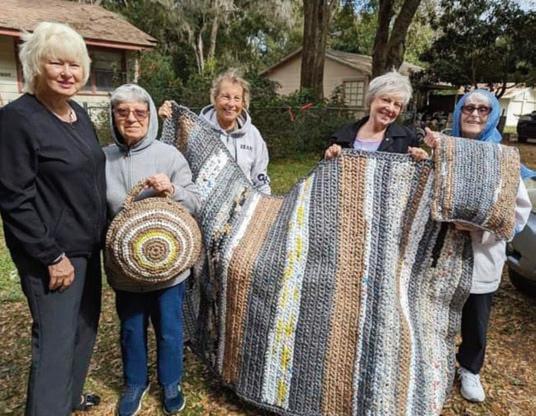
Gail was recently asked, ‘When will gathering bags and supplies end?’ She replied: “We will stop helping when there are no more homeless here in our county.”
“The Charity of Christ urges us on … urges us onwards day by day… Alleluia! Alleluia! Christ’s love will show us the way!”
* Florida Associates mentioned above include: Gail Metcalf, Theresia Griffin, Liz Hickey, Cathy Palmer, Debbie Garland, Geri Anderson, Helen Snoha, Iris Ramirez, Peggy Brockman, Margaret Martin, Anna Nelson and Candidates Pat Augustyniak, Pat McNiff, Janet Parente, Dianne Clark.



 By S. Regina Kusnir
By S. Regina Kusnir
Music flows through S. Terry Thorman. Her ministry of music gives life to what Pablo Casals once said, “Music is the divine way to tell beautiful, poetic things to the heart.”
S. Terry sought to use her music teaching gifts to “work directly with those who would be considered less fortunate.” A call in 1990 from Bruce Weil, who formed a steel drum band of children at Peaslee Neighborhood Center (Overthe-Rhine, Cincinnati), invited her to teach piano to the drummers so they could read music notes.


“I knew this was what I’d been looking for!” she recalled. She taught piano to 10 drummers from Peaslee’s Steel Drum Band, then to children from the ‘Homework Room’ and by referrals to others in the neighborhood. The program expanded and other piano teachers were hired to teach with her for the next 30-plus years; to this day it continues to be Peaslee’s longest running program.
“I retired from active part-time piano teaching at Peaslee in May 2022,” S. Terry says. “I was always learning from those who had such different life experiences from me – racial, employment, education, income, housing, life opportunities, etc. As they were playing the piano I was learning much about a very different culture. Poverty is a culture.”

“I met ‘Miss June’ at an open house at Peaslee in 2008,” recalled S. Terry. “She was invited by S. Mary Grafe, an outreach social worker. I asked if she would like to take piano lessons. To my surprise she said an immediate ‘yes’ having taken some lessons as a child. For the next 10-plus years we had weekly lessons. Over time we became friends. We shared May birthdays and usually celebrated. She enjoyed good food but let me know that she enjoyed talking even more.”
Miss June lived in “Tender Mercies,” a group home for those homeless with mental illness. A highly skilled artist, a brilliant scholar (two degrees in the arts), a student of piano, and a breathtaking writer, June connected to opportunities at Peaslee. She taught children art, supplied table environment for benefits, and accompanied staff to City Hall meetings to advocate for people like herself. She mentored informally by talks with staff or piano students and more formally with groups of Miami University students who spent time living in the area and coming for education by the staff.
Miss June progressed at the piano and S. Terry offered challenging repertoires and comments. “I learned that adults often ‘just want to have fun.’ The assignment: ‘What would you like to do next?’ We wrote a song about her Peaslee family experience, shared it with others and performed it at a Peaslee benefit. Our song reappeared at my ‘retirement’ celebration last May when she gifted me with a signed copy,” S. Terry fondly remembers.
Yes, Miss June had a roof over her head and appreciated what Tender Mercies “did with the resources they had.” Yet her life lacked some basics:
• A room for her keyboard where she could play at the shelter.
• A place to make art (she had to store supplies elsewhere) as she lived in a single room.

• A healthy environment minus allergy-inducing cleaning supplies.
• A yard with fresh air.
• Fresh and healthy food availability.
• Good, affordable medical care.
• An apartment of her own.
“Miss June died in the lobby of Tender Mercies Shelter on Sept. 28, 2022,” S. Terry recalls. “Having serious trouble breathing, she called 911, went to the hospital where she was ‘stabilized’ and taken back to the shelter. She died shortly thereafter in the entrance room. June was just 62 years old yet considered a wise elder to the community. Josh Spring, a fulltime worker with and huge advocate for the homeless, stated in her eulogy that Miss June died of poverty. He didn’t think it was her time to die. ‘She still had a lot to give.’”
S. Terry says, “When I am at Peaslee, I do not experience a difference between my value system and the values of people who become part of the staff or long-time participants in our programs. Isn’t that like heaven? To be looking in the same direction? I just know that God put me at Peaslee. I am still there attending piano recitals of my successors, participating in Women Writing for a Change, attending benefits and whatever opportunities may come up.”
“Humility, Simplicity, Charity” is the SC way to re-state the Golden Rule in harmony with Christ in the poor.



 By S. Patricia Wittberg
By S. Patricia Wittberg
All houses built in this country must include, by law, certain essential features: a roof, walls, electric wiring, plumbing, a kitchen, a bathroom, and a furnace, for example. These components cost a building company roughly the same amount whether the company is building a small house in a low-income neighborhood or a large house to sell in a wealthy suburb. For-profit building companies prefer, therefore, to build large homes, and to add on “extras” like fireplaces, three-car garages, and granite kitchen counter tops, which will raise the price of the house more than these extras cost them. For several decades, constructing smaller new houses that would be affordable to working- or lower-middleclass families has been neglected in favor of building everlarger and more expensive ones, thus decreasing the number of houses available to the working and middle classes.
It has gotten worse recently. House builders at all levels have been faced with rising costs for building materials, with labor shortages of construction workers, with rising bank interest rates, and with supply chain bottlenecks. This drives the price of new houses up even more. The cost increases also affect those who want to repair existing housing. The gap between the number of affordable homes and the number of families needing them increased by another 500,000 fewer available homes during the pandemic. There is now a shortage of 7,300,000 homes (houses or apartments) needed to be affordable to the poorest families in our society.
The Seton Enablement Fund, started by the Sisters of Charity to provide low-interest loans to organizations and projects unable to qualify for conventional financing, lends money to a number of nonprofit organizations that are helping redress this gap. Some, like Working in Neighborhoods in Cincinnati, FORGE in Arkansas, and Homewise in New Mexico, help first-time low and moderate income families buy their first homes. Others, like HDC Community Loan Fund in Oregon, Mercy Community Capital in Colorado, Midlands Housing Trust Fund in South Carolina, and the Genesis Fund in Maine, provide lowinterest loans to local developers who are building affordable housing. Some of our borrowers target particular groups: Options for Supportive Housing in Ohio helps finance homes for people with developmental disabilities who are living at 30 percent of the poverty level; Four Directions Development Corporation in Maine invests in affordable housing for the Wabanaki tribes in that state; and the San Luis Obispo

County Housing Trust Fund in California targets very low, low, and moderate income residents including families with special needs. In areas subject to gentrification and rapidly rising housing costs, some SEF loans help nonprofits keep housing affordable to families who have less money: Camp Washington Community Board does this in Cincinnati, as does the Sawmill Community Land Trust in Albuquerque, New Mexico. Of the 54 loans and investments currently funded by the Seton Enablement Fund, at least 20 are devoted, in whole or in part, to developing affordable housing. And we are always looking for more opportunities to help. To quote a recent article in the New York Times (June 14, 2023, Page B4), “the need has never been as high as it is now.”
As a result of the SEF loan proceeds, AHSTI has facilitated post-purchase training to the community by providing basic home repair, maintenance training skills and other services such as free will clinics, all free of charge, through the Fred Munguia Training House.
It has been such a joy to experience a new committee being formed in Mother Margaret Hall these past months. When Eileen Gumbert joined us, as a social worker, she called a meeting for the Community Action Committee. I had not been to that type of committee meeting since I moved here. Surely this kind of service has been done for a long time by those of us living in Mother Margaret Hall.
This first meeting we, Sisters with help from employees, were asked to do something for others but do it together. Eileen asked us to list organizations that we thought might need help. Our list of possibilities was endless; we were ready to help!
“I am so impressed by the Sisters and everything they have accomplished in life. The Community Action Group seemed like a natural extension of their work. I only created a framework; the Sisters came up with the suggestions, planning, and work to make it happen. We have help from the Activities and Spiritual Life departments, and all Sisters and staff are welcome.”
- Eileen Gumbert,

Some of the organizations suggested were shelters for the homeless where people needed food; in Ohio, 270,000 households experience food insecurity. Some organizations named were assisting those in need of housing; in Ohio, a 2023 Gap Housing report said the “affordable housing shortage is getting worse.” And other organizations mentioned related to children’s needs; in Ohio, 76,000 children suffer food insecurity.
At that initial meeting we chose two possibilities to begin right away. We wanted to make sandwiches for Our Daily
Bread Soup Kitchen, and we wanted to help Healthy Moms & Babes with their many needs.
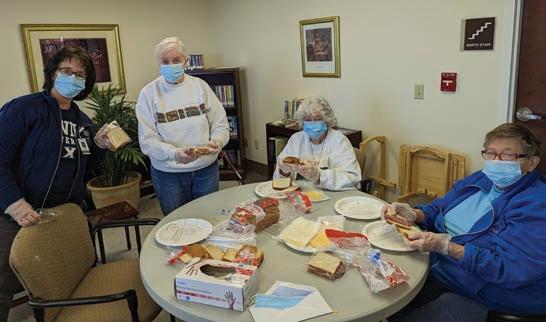

Our Daily Bread Soup Kitchen is a nonprofit soup kitchen and social center in Cincinnati, Ohio’s Over-the-Rhine neighborhood that offers meals, hospitality and services in a safe, respectful environment. The organization requests 600 sandwiches a day to send home with their clients who often live on the streets. Clients come in for a hot meal and also leave with sandwiches to eat later in the day. The organization has an online algorithm where a group can sign up for 100 sandwiches at a time for any day of the week. We have now provided sandwiches to the organization twice this year. And, through our participation, other groups have started to sign up. An elementary school classroom made 100 sandwiches for the organization after hearing about the project through our involvement.
Healthy Moms & Babes is an outreach ministry whose mission is to increase infant survival as well as foster the health of women, children and families; S. Tricia Cruise serves as president/CEO. This project took more planning and discussing. We wanted to have a baby shower for the families to gather gifts and donations. When we were ready to host the shower, we collected baby pictures of Sisters, staff and Associates to display; it was a fun guessing game. We played shower games, and there were split-the-pot and other opportunities to have fun and earn money. A portion of the money went to purchasing items for the mothers and their babies. The Sisters helped sew tote bags that would carry all the presents. When finished we filled 24 tote bags with muchneeded items like wipes, socks, shirts, lotion and so much more.
We had fun doing service for the two groups and we know God blessed those we served with just a bit of what they needed. We look forward to determining who will need our service next.
Social worker Eileen Gumbert (right) organized the Mother Margaret Hall Community Action Committee, which has hosted activities to benefit local nonprofit organizations with their needs. Sisters and employees made lunchmeat and peanut butter and jelly sandwiches for Our Daily Bread Soup Kitchen in Cincinnati. MMH social worker“We Associates of the Sisters of Charity of Cincinnati are women and men striving to live the Gospel values. Called by God, we choose to be in mutual relationship with the Sisters of Charity guided by their Mission Statement. We commit ourselves to participate in this mission through our individual life situations.” ~ Associate Mission Statement

It was a letter written by S. Jane Grosheider in 1973 that set in motion a conversation which would change the face of the Sisters of Charity of Cincinnati. Sister’s suggestion was to begin a relationship with individuals in the Christian community which would “provide support and encouragement to persons who share our values and vision of life.” From the very beginning the Associate relationship was seen as a “unique companionship” – Sisters and lay people walking the journey of faith together.
In September 1973, Blasa Rivera made her commitment in Pueblo, Colorado, as the first Associate (then called Auxiliary member) of the Sisters of Charity of Cincinnati. Two other women followed soon after and the Associate/ Religious relationship was born. Throughout the years, the relationship has grown and flourished with approximately 200 women and men throughout the United States (including one in England) impelled by the Charity of Christ to share friendship, faith and action with the Sisters. They are women and men, single, married and divorced, Catholic and Protestant, even vowed members of other
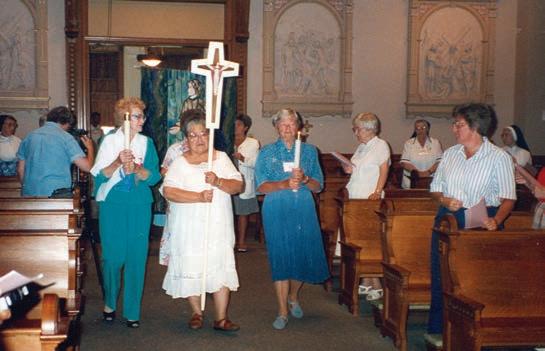
religious communities. All search for meaningful spiritual life enhanced and informed by the vision of Elizabeth Seton. Some Associates volunteer directly with sponsored ministries of the Sisters of Charity Community, some work in parishes, schools, hospitals, and in social justice activism. Others are quietly the caretakers of their families where they bring the legacy of love and service to the next generations.
In September 2023, the Community will commemorate the 50th anniversary of the Associates. This milestone has only been marked by a handful of other Associate programs in the United States and demonstrates the swift response of the SC Community to the documents of the Second Vatican Council urging religious communities to envision new ways to embody their mission and spirit. Throughout the years the Associate program has seen changes and growth, however, through it all endured a strong support from Sisters to continue the relationship as a viable way of sharing the charism, mission and ministry of the congregation.
S. Rita Hawk was named the first director in 1993 followed by S. Mary Ann Humbert, Mary Jo Mersmann and now current director Chanin Wilson. New opportunities such as Associate in Volunteer Ministry and Associate in Community were added. More recently, with Associates living throughout the country and abroad, the Community added seven regional representatives to volunteer in a shared leadership model with the director of Associates in order to maintain closer connections. Evolution is key as the Community journeys together into this ever-changing future.
“In my years as an Associate, and now as director of the Associate program, I have witnessed the deep-rooted commitment of the SC Associates as they individually live out their own personal call to the mission and spirit of the Sisters of Charity of Cincinnati,” says Director of Associates Chanin Wilson. “Each is on their own spiritual journey and have found strength, enrichment and support from the Sisters willing to walk with them.”
The theme for this year’s anniversary is “Called by Spirit, United by Love.” Additional events, information and feature articles will be highlighted on the SC website and social media pages as the date approaches. Please visit our website to read more (www.srcharitycinti.org)
 By Associate Vicki Welsh
By Associate Vicki Welsh
In this issue of the Intercom, we spotlight Associate Pat Schloemer. Pat is the longest living Associate, having made her initial commitment on May 20, 1979, and her lifetime commitment on Sept. 7, 2013. Pat has been an Associate of the Sisters of Charity of Cincinnati for 44 years.
On this summer day I arrived at Bayley, an assisted living facility across from the Motherhouse in Delhi, with my lunch in hand. I was hoping Pat and I could have a pleasant chat, walking down memory lane. I’ve known Pat since I became an Associate 20 years ago.
Pat was born on May 13, 1929, and baptized at Holy Cross in Mount Adams (Cincinnati, Ohio). She attended elementary school at St. Mark’s and graduated from Ursuline Academy in 1947. After Pat was married, she and her husband located in Price Hill (Cincinnati) and became members of St. William parish. “St. William is the most beautiful church – anywhere!” she says with great gusto. All five of their children attended St. William Elementary School where Pat was the school librarian for 25 years. Her three sons graduated from Elder High School and her two daughters from Seton High School.
Pat cites her earliest connection with the Sisters of Charity came with her aunt, S. Clotilde (Katie) Higgins. She would visit Sister wherever she was missioned. In fact, Pat was able to walk from her grandmother’s house in Mount Adams to the Holy Cross Convent, where S. Clotilde lived for a while.

She also came to know all 16 of the Sisters of Charity who taught at St. William and lived on site.
As Pat became involved with Christ Renews His Parish at St. William, she came to enjoy getting to know a group of women who shared their faith and sought the deeper meaning of scripture. Sisters often joined these groups. Pat said, “I was amazed at the stories of their lives in the light of faith.”
In the early days, Pat says the Sisters would call the women they invited into relationship auxiliary or co-members. At first it was only about six women with two Sisters who would pray together in a little room set up like a chapel. The Sisters would invite the ladies to special celebrations.

“Learning about Mother Seton, her love of the Eucharist and sacred scripture, and reading her letters helped me to look at the challenges coming into my life as Elizabeth would have done. What a wonderful model for me,” Pat remembers.
She continues, “I know the Lord led me to this relationship with the Community. I have known the support of the many friends I have made and have felt the power of their prayers offered for me and my family during some difficult times. I have a sense that whatever I do has a deeper meaning because I have joined with other women dedicated to loving and serving our God. My prayer is ‘thank you!’”



As Sisters and Associates of Charity, the call to be doers of justice and makers of peace has been historical, impactful, and pervasive in our ministry endeavors. Moving into our future, embodying the tenants of Catholic Social Teaching will be no less compelling.
In November 2020, the congregation began taking steps to redesign our social justice advocacy and engagement ministry. In the two years since, a visioning task force of Sisters and Associates developed a process to identify the sort of program we need at this time.
Through this process, the visioning task force gathered data about the justice projects and interests Sisters and Associates support. Sisters and Associates were asked to participate in small group meetings, gathering to talk about their passion for social justice and provide their wisdom to the visioning task force.
The task force also set up Zoom conversations with partners from the Sisters of Charity Federation, LCWR, NETWORK LOBBY for Social Justice, Ignite Peace (formerly IJPC, Cincinnati), Giving Voice, Leadership Collaborative, Pax Christi, Ohio Sisters Justice Network (formerly Ohio Nuns on the Bus), Action, and Soteni International. S. Andrea Koverman, educator and passionate advocate for ending the death penalty, took on the task of organizing conversations with younger religious and Associates with the task force, which proved particularly beneficial for understanding the current landscape of justice ministry.
“Catholic Sisters tend to engage questions about the unjust systemic and structural issues,” says S. Sally Duffy, justice advocate and long-time educator. Jenny Brady, SC Associate and director of Soteni International, adds, “Sisters are not scared off by the complex and divisive issues of our time.”
“Catholic Sisters have always been in the forefront of addressing justice issues,” says S. Caroljean Willie, director of EarthConnection, “but we have also become a part of the very systems which are now causing the problems. We need to become aware of our own participation in these systems before we can confront them. This will be both a painful and humbling process, but one to which I think we are called today.”
S. Louise Lears frames the call to justice ministry in today’s world as knowing who we are as public witnesses of the gospel. “We are gradually understanding the depth of our privilege and the responsibility to address that privilege in our justice work,” says Sister, who serves as a creation care advocate at Franciscan Action Network in Washington, D.C. She adds, “We are learning that our justice ministry is still viable and vibrant — and needed!”
For what are Catholic Sisters and Associates needed in the ministry of justice and peace today?
A key value grounding our justice ministry moving forward is collaboration.
Over and over the visioning task force heard collaborators close to our mission describe the reasons for which we are needed at their table. Sisters and Associates have been on the front-lines of justice ministry for decades. What has changed, as our conversation partners acknowledged, is that “Sisters are no longer the initiators or the leaders within the organizations, but rather bring invaluable experience, wisdom and resources to the table.”
“Never forget that justice is what love looks like in public.”
When it comes to justice ministry, Sisters witness the commitment and faith-filled struggle to embrace transformational behaviors, influencing others to risk making necessary changes on behalf of the most vulnerable,” commented Ken Butigan, professor at DePaul University and task force conversation partner.
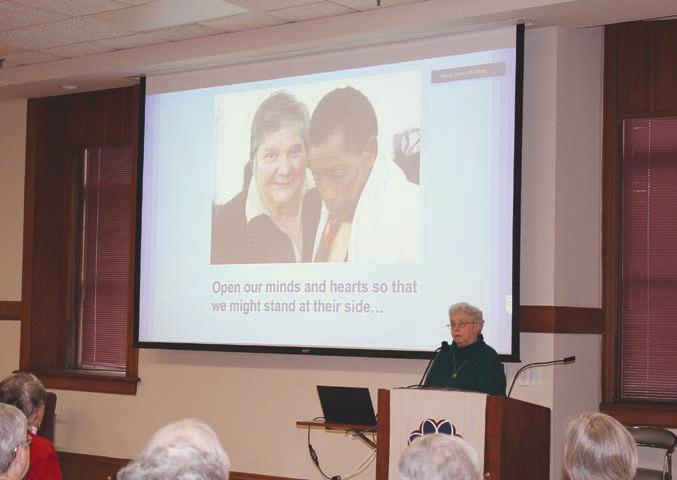
“Sisters work toward systemic change—even as they provide much needed relief for those living in poverty.” Their approach is “to work patiently, accompanying the most vulnerable, while empowering them to become advocates for themselves,” Dr. Butigan continued.
In the spirit of “solidarity and subsidiarity to which we are always called,” says S. Sally Duffy, “involving the most impacted in any decisions related to their programs or solutions to their struggles must be a priority. They need to be at the table with us—speaking their truth and being fully heard.”
“Collaboration takes place on several levels – among religious congregations themselves (Sisters and Associates), but also with partners in our multiple ministries. Education about the causes of injustice is key as is the need to develop a strong voice which is not afraid to confront with knowledge and concern those in power in the institutions of which we are a part… Learning the tools to do this effectively is important,” says S. Caroljean.
In a time when trust in public figures runs low, “Sisters have ‘street cred’ – especially with the younger generation,” according to S. Louise, ethicist and longtime activist. “Justice ministry moving forward will be intergenerational and even more collaborative. We can learn from one another.”
Our new program format will likely help us manage the impulse to have “everyone doing everything all at once.”
Over the past year, five Justice Circles have formed. Justice Circles are self-organizing groups of Sisters, Associates, colleagues and collaborators who regularly come together around a focused issue such as immigration reform, renewal of Earth, homelessness, food insufficiency, violence, etc.
Geographically well-represented, Justice Circles meet together on Zoom and in-person unless the members determine otherwise. This makes it possible to include collaborators from all over the globe. They can be initiated by an individual, groups, or the Visioning Task Force.
Justice Circles commit to participation in actions, educational opportunities, and resource support, often
organized by collaborators who are invited by members of the Circle. Justice Circles also have the responsibility to call themselves to completion. Sisters and Associates can also participate in Circles through the ministry of prayer.
“It has been very exciting to see Sisters and Associates collaborating around shared passions in the Justice Circles,” comments Associate director and member of the task force, Chanin Wilson.
Sociologist and director of the Seton Enablement Fund, S. Patricia Wittberg, agrees. “I have really been impressed with how active the Associates have been in our Justice Circle, and the innovative ideas they have come up with. It has been great working with them and getting to know them better!”

No collaboration seems more natural or timely than that of working with other religious communities. “Our long-term connections with other women religious positions us to have a collective impact on education and advocacy for justice,” says S. Louise.
Injustices are complex, systemic, and relational.
“We are just beginning to imagine how to involve the broader community in shared justice work. And how to address the intersectionality of our issues,” says S. Louise.
S. Caroljean reflects, “Injustices are not single issues, but integrally connected in a system that fosters injustice for the sake of economic gain. Catholic Sisters have long been at the forefront of meeting the needs of the marginalized through providing educational, social service and health care opportunities, but isolated initiatives are not enough when the problems are systemic.”
Intersectionality also acknowledges that “injustices imprint themselves across social institutions,” according to justice advocate and author Eliza Sullivan. “Intersectionality is a framework for understanding the complex way that the many aspects of people’s identities overlap, including their race, gender, sexual orientation, class, and more…”
Justice Circles are also committed to examining issues through the lens of equity. As stated by United Way, equity means “meeting communities where they are and allocating resources and opportunities as needed to create equal outcomes for all community members.” Dominican Charles Bouchard asserts, equity “is the state where each has received his or her due, not necessarily in equal measure, but in a way that matches needs and aspirations.”
S. Emily Tekolste, SP, states, “… equity aligns with our Catholic and Christian notions of human dignity …






“… [W]e see that it is actually an injustice to ignore social, political, and economic systems, our history, and our own individual abilities, needs, and circumstances. Refusing to consider these realities ignores the very image of God that resides in each of us as individuals” (Global Sisters Report, September 2021).
In keeping with the call from LCWR, Catholic Sisters are working across our congregations to address racism. As Fr. Bryan Massingale notes, “Racism in America is the spiritual cataract limiting our vision, determining who we do and do not notice.” Martin Luther King called racism a “soul-sickness.” As Sisters and Associates of Charity, we commit to the inner-work necessary for healing this soulsickness of racism.
Removing the cataract of racial bias, white privilege, and pernicious alienation from our shared God-given humanity is a mission priority. Justice Circles are all committing to anti-racism, the “practice of actively identifying and opposing racism by working to change policies, behaviors, and beliefs that perpetuate racist ideas and actions.”
“As we continue to realize the systemic nature of injustice, we can respond through offering education on the nature of systemic change as well as agreeing to action steps we might take to address injustices locally,” comments S. Caroljean. Working locally is a contribution to chipping away at the global injustices that diminish the planet.
Justice Circles will be supported by the congregation’s new Justice Promoter, Mackenzie Doyle, who began her ministry fulltime in mid-August 2023.

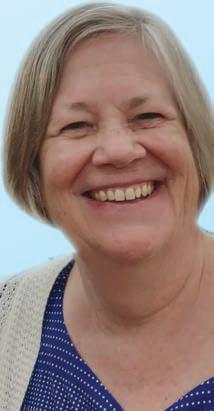
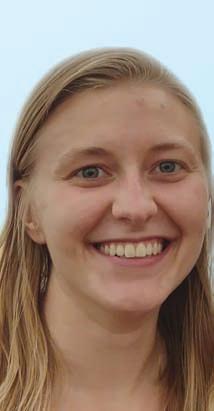
Mackenzie’s immersion into Catholic Social Teaching was as a member of Old St. Patrick’s Parish in Chicago, Illinois, which just happened to coincide with her immersion into the criminal justice system as a police officer. Ultimately, Mackenzie found herself questioning and rethinking her career trajectory, and in time explored the possibility of justice ministry by enrolling in a master’s degree program at the University of Dayton. Feeling at home in this ministry, Mackenzie quickly came to recognize that interrupting unjust systems is about making space for institutional reforms and personal conversion—a path she feels ready to walk with the Sisters of Charity of Cincinnati.
“Mackenzie is such a great fit for our future—she will represent the Sisters of Charity with a passion grounded in her lived experience of institutionalized injustice and her desire to positively influence and empower younger generations,” says S. Mary Bookser, a member of the interview committee.
For more information about joining a Justice Circle or the ministry, contact Mackenzie Doyle at mackenzie.doyle@ srcharitycinti.org.
Members of the Visioning Task Force for Social Justice Ministry commissioned in 2020 by the SC Leadership Council: Associates Chanin Wilson and Vicki Welsh; Sisters Mary Bookser, Sally Duffy, Andrea Koverman, Marge Kloos, Louise Lears, Caroljean Willie, and Patricia Wittberg.
 By S. Caroljean Willie
By S. Caroljean Willie
As we move through these summer months, we are seeing the effects of climate change everywhere: record-high temperatures being broken repeatedly, hurricanes forming earlier than ever in the Atlantic, catastrophic flooding and forest fires raging out of control affecting the air quality thousands of miles from their origin. In her book “Under the Sky We Make,” Kimberly Nicholas, Ph.D., states clearly, “It’s warming. It’s us. We’re sure. It’s bad. But we can fix it.” The question before us today is: “Do we want to and are we willing to take the necessary steps to do so?”
The most recent U.N. Intergovernmental Panel on Climate Change (IPCC) found that the world is likely to surpass its most ambitious climate target — limiting warming to 1.5 degrees Celsius (2.7 degrees Fahrenheit) above preindustrial temperatures — by the early 2030s. This most recent assessment by the IPCC synthesizes years of studies on the causes and consequences of rising temperatures.
In unequivocal terms, the report states, “The world is likely to pass a dangerous temperature threshold within the next 10 years, pushing the planet past the point of catastrophic warming — unless nations drastically transform their economies and immediately transition away from fossil fuels.” Scientists have found that beyond that threshold “climate disasters will become so extreme that people will not be able to adapt. Basic components of the Earth system will be fundamentally, irrevocably altered. Heat waves, famines, and infectious diseases could claim millions of additional lives by century’s end.”
“Human activities have already transformed the planet at a pace and scale unmatched in recorded history,” the IPCC said, “causing irreversible damage to communities and ecosystems. Yet global emissions continue to rise, and current carbon-cutting efforts are wildly insufficient to ward off climate catastrophe.”
EarthConnection’s (EC) mission is to provide people with up-to-date information regarding the realities of climate change, but also to provide steps we can take to make a difference. Our programs host webinars with international speakers as well as on-site guests who offer both global and local initiatives. We also strive to help people to see the connection between faith and care for creation. The book “Faith for Earth: A Call for Action,” co-published by the World Parliament of Religions and The UN Environment Programme, clearly outline what faith traditions throughout
the world believe about care for creation as well as the initiatives congregations are taking to both mitigate and adapt to our changing reality.

S. Winnie Brubach, master gardener, continues to work with volunteers to grow fresh vegetables to share with clients at the Good Samaritan Free Health Center in East Price Hill as well as offer presentations for Cincinnati State Technical and Community College. She has also worked with a local landscaping company to provide all native plants outside of EC.
Associate Sue DiTullio, administrative assistant, is continuing to spearhead the effort to finish our plastic bottle/ lid project. One more trip to Evansville to pick up a bench provides EC with two picnic tables and four benches and has saved more than one ton of plastic from the landfill.
S. Caroljean (Cj) Willie gave a presentation at the Archdiocese of Cincinnati’s day-long event at the University of Dayton on the Laudato Si’ Action Platform. She continues working as co-chair of the Faith Communities Go Green city-wide initiative and as a member of the Core Group of Sisters of Earth. She spent the month of July in the country of Panama providing a variety of workshops to teachers, catechists and community groups on environmental sustainability.
 By S. Judith Metz
By S. Judith Metz

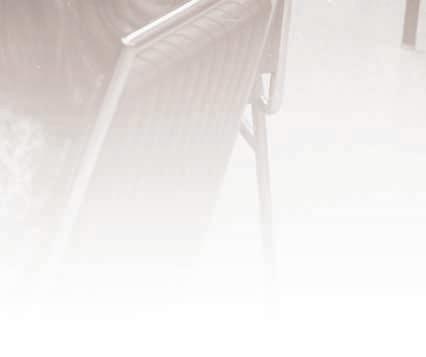


As the ministry at St. Joseph Home continued into the 1920s, 1930s, and beyond, the Sisters, doctors, nurses, and support staff continued to view their work as a sacred trust. The unwed mothers, often bewildered and distressed, continued to appear at their door, as did many orphaned and abandoned children. As one young women who sought shelter said, “I shall never forget [the Sister’s] great kindness. I went to her without any means, but it made no difference to her – she saw I was poor and needed shelter.”

Following the 1923 Golden Anniversary celebration, a steady stream of changes and improvements were made, many under the leadership of administrator, S. Mary Paul Doyle. Interior renovations and modernization of the facilities were a priority. A formula room was set up, sterilization equipment purchased, and an infirmary with an isolation ward added. These improvements were accompanied by adding staff physicians and additional registered nurses who provided medical and nutritional supervision for both the mothers and the babies. The addition of caseworkers affiliated with Catholic Charities led to a more comprehensive system of record keeping. Changes in regulations and procedures followed, including annual visits from the Ohio Department of Public Welfare who provided oversight and recommendations.
An additional 33 acres were added to the original eight that Joseph Butler purchased in 1873. Some of the property was wooded, while areas close to the buildings were landscaped to create space conducive to recreation and relaxation. In 1928 a small colonial frame building was erected for a kindergarten. This separate facility gave the children the experience of going out to school into an environment different from their living quarters. The play area was fully equipped with sand boxes, swings, slides and other outdoor recreational equipment. At the recommendation of the Department of Public Welfare, the kindergarten-age children were moved to St. Joseph Orphanage in 1936. St. Joseph Infant Home then opened a nursery school for 2½ to 4-year-olds in this building. This yielded good results, allowing the younger group to receive more individual attention and instruction.
Three services continued to be provided at the Home. About 30 elderly women called the central building home, while the building to the west housed the maternity hospital and living space for the unwed mothers. The infant home, housing well over 100 children, was located in the east building where children from newborns to 6-year-olds (later 4-year-olds) lived. Many of the newborns were soon adopted, while a good

number of the orphaned and abandoned children remained there until they moved to St. Joseph Orphanage.

Divided into four separate nurseries according to age, each area was equipped with a dormitory, dining room, recreation room, and bathing and lavatory facilities. The rooms were equipped with age-appropriate furniture and toys, and the children were directed and supervised by a group mother. One group mother who merits particular mention is S. Mary Francelline Ryan. After repeated requests to her superiors, this petite and energetic Sister was assigned to the toddler’s division at St. Joseph Home in 1924. With an interruption of only two years, she spent 46 years with her little ones. Her Irish wit and loving manner delighted not only the children but also the unwed mothers, the student nurses, and all who worked with her at St. Joseph’s. She was on 24-hour duty with her bedroom just off the children’s dormitory, so she responded to anyone’s needs at any hour. S. Francelline loved her “darlings” and nothing was ever too much in the care she bestowed on them.
By the time S. Marie Agnese Bonanno arrived as administrator in 1954, there were a growing number of Sisters serving as nurses, child care workers, secretaries, bookkeepers, in the milk laboratory and in the kitchen. Sometimes more than 200 children and 45 unwed mothers required their services. A significant change that year was the closing of the Maternity Hospital after 81 years. Services were no longer available for neighborhood mothers to deliver there, while unwed mothers from St. Joseph’s delivered their babies at Good Samaritan Hospital.
The women who came ranged in age 12 to 49 representing every religion and race. A young woman usually arrived in her third or fourth month of pregnancy and stayed from six weeks to four months after delivery depending on whether she kept her baby. Most were given up for adoption. Those who could paid $125 that included medical and
hospital care as well as food and shelter. Most worked in the nurseries while they stayed at St. Joseph’s. Many of the unwed mothers came from good homes and were well educated, others were from tragic circumstances. Some were completely alone and desperate, having been rejected by their families. These had no money, and only the clothes they were wearing.
S. Redempta Wittberg, an experienced pediatric nurse, arrived in 1955 as director of the Children’s Building where 60 babies under the age of 1 lived. Three years later a representative of Proctor & Gamble approached her to do research on paper diapers. “I needed the money for improvements at the Home, so I said ‘yes,’” she recalled. For the next two years she experimented with various shapes, padding, glue, inner lining, and flap sizes in different combinations. “The nursery could have been declared a DISASTER area,” she said. “Diapers fell off, lining around the bed, leakage, torn at the pin area.” The research was cloaked in secrecy, while she filed weekly reports to the company. After two years a satisfactory product was developed, named “Pampers,” at her suggestion.

S. Redempta’s need for money for improvements at the Home was not a unique situation. Although St. Joseph’s received a portion of its funding from United Appeal each year, from its founding it had depended on donations and volunteers to assist in fundraising activities. These important contributors did landscaping and sewing, they donated toys at Christmas, and hundreds provided a work force for the annual Lawn Fete. Some parishes sponsored monthly card parties, and others helped collect Pepsi Cola caps by the pound. These were sold for cash that resulted in the purchase of two suction machines for the nursery. Some collected Nabisco labels for which St. Joseph Home won $1,000 that yielded a new freezer and new coffee urns.
Good fortune arrived at the door in 1956 when Nancy Ihlendorf appeared at the door and asked if St. Joseph’s had

became the administrator of
a guild. Nancy’s family and friends became charter members of a guild that grew over the years to include more than 400 participants in over 22 chapters. These women sponsored many fundraising activities for decades, making an invaluable contribution to the success of the Home. Annual reports list new purchases or replacements, many of which are the result of the work of the guild as well as monetary donations and equipment from both individuals and companies.
S. Ellen Joseph Walsh was destined to oversee substantial changes at St. Joseph’s when she was named administrator in 1964. Her partner in overseeing and adapting to new programs and new facilities was S. Rose Eileen McGinnis, a nurse who had already served at St. Joseph’s from 1946-’52, and now returned and would remain for the next 30 years as nursing supervisor and assistant administrator. In 1965 the leadership of the Sisters of Charity decided that the Sisters would establish a certified high school program for the unwed mothers at St. Joseph’s. This decision represented a major change. From its founding the Home never had a clearly defined educational program for the mothers. The Sisters always provided prenatal instructions, lessons in personal hygiene, diet, and clothing and care of the young infant. The mothers gained general knowledge of child care from assisting the Sisters in the nurseries. They also had access to optional religious services, instructions, Days of Recollection and a resident chaplain, Rev. Jerome O’Reagan.
When S. Ellen Joseph learned that an academic program was to be set up for the young residents, she exclaimed, “But Sister, how can this be done? There is no space, no books, no teachers!” She was assured by S. Marie William McDonald, the director of the new program, that “equipment needs are minimal – a card table, chairs, and four high school students will suffice.” Seton High School promised to supply textbooks and grant credits for the courses completed by the students. “The tree will grow if it is God’s project,” she assured S. Ellen Joseph.
The program was immediately approved by the Ohio State Department of Education, and Sisters of Charity were
enlisted as teachers. “Our first school budget was $50,” according to S. Marie William. A blackboard, bookcases and a bulletin board were “unearthed” and the school was on its way. The Cincinnati Public Library and Princeton High School became enthusiastic supporters of the program that was well received by the prospective students.
Simultaneous with the creation of the high school program, the Sisters of Charity announced that St. Joseph Home would move to a 20-acre location on Wyscarver Road in Sharonville. The new campus was to include single rooms for the unwed mothers as well as modern, completely equipped classrooms, up-to-date nurseries and medical facilities. September 27, 1967 was moving day. The event was celebrated with a parade of 50 gaily decorated cars, escorts of police and firemen, a sound track car provided by the American Legion, and a welcome by the mayor of Sharonville. By November, when everyone had settled in, a series of open houses were held, culminating with one open to the public that attracted more than 2,500 people.
Within a few years of moving to the new facility, it became apparent that the focus of the programs needed to change as smaller numbers of unwed mothers and babies required services. The Sisters and the Board began to explore an unmet need in the community – a facility for infants and children with profound mental and physical deficiencies. In 1976
S. Mary Rita Vieson, administrator, directed the closing of the newborn nursery. This space was then used to start a program for profoundly disabled, non-ambulatory children. By the end of the year the program was serving 26 children. Soon a robust group of volunteers and foster grandparents were assisting staff with dressing, feeding, and companioning the children. The introduction of the Sensorimotor Integration Program allowed the children access to a special school curriculum.
Through these years many semi-retired Sisters of Charity resided at St. Joseph’s and offered their services where needed. Some, like S. Beatrice Anne Garlock, had previously been on staff from 1937-’53 as a group mother. She returned as a teacher in the high school, and later assisted with sewing for a total of 26 years of ministry. Another former administrator, S. Marie Agnese Bonanno, contributed craft and needlework to such an extent that the gift shop was renamed to honor her dedication to the Home.
In 1986, when S. Marianne Van Vurst became administrator, she immediately recognized that a growing wait list and inadequate facilities required action. After 116 years she closed the maternity home to allow for the expansion of the developmental disabilities program. In 1990 she initiated St. Joseph’s first-ever capital campaign for renovation and new construction to accommodate the need of residents and staff. S. Marianne’s administration touched off a new era of dramatic growth for St. Joseph Home.







 By Erin Reder
By Erin Reder
As a child growing up in northern New Mexico, Tomas Sanchez had heard the stories of a strong, hardworking, courageous nun who had run-ins with Billy the Kid. The tales, at times, seemed hard to believe, but then again, her work and legacy continued to thrive throughout the Southwest through the hospitals and schools she had built. Her story was intriguing, even as a young child.
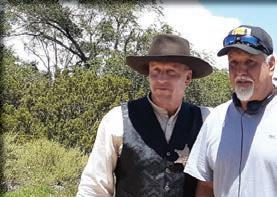

Fast forward a few decades, as a grown man beginning his directing career in the film industry, Tomas recalls sitting with his dying mother and coming across the story of that heroic nun in a comic book collection he had from his younger years. His mom told her son that the stories of S. Blandina Segale were recorded in a book and that he should consider putting his time and effort into making these types of stories, ones that matter. He took the words to heart and eventually began developing films about his Catholic faith. In 2017 Tomas set out to make a pilot for a television series based on the life of Servant of God, S. Blandina Segale.
The road was not easy, as he explains. Hollywood did not seem too interested at the time in doing a faith-based film. He was frustrated and decided to use his own money to make the pilot, telling himself that once they saw the story they would change their minds. “I wanted to stay true to her story and words,” said Sanchez. “She had a mission and her mission was to be there to save the sinners, not the saints.” Using her journal, “At the End of the Santa Fe Trail,” as his guide, he carried forward with the project – and then the COVID-19 pandemic hit. Persistent, Sanchez knew this story needed to be told and changed gears, making the series into a feature film. In his mind he felt S. Blandina’s story could still be told and future endeavors could unfold once the world knew more about this heroine. “She was the light coming out of the darkness of COVID,” he said, “we all needed that story.”
Sanchez compares S. Blandina to a modern-day superhero. Never backing down from a challenge, standing up for justice, and physically and mentally strong, she serves as a role model and inspiration through the life she lived for others. Finding the right person to play S. Blandina was key to the success of the film. “I needed an actress who was strong, had a big heart and really understood S. Blandina.” Enter actress Alma Sisneros. She and Sanchez had worked together on a prior television series
and he knew she embodied the spirit and grit he was looking for. Sisneros was also willing to travel to the Mount St. Joseph Motherhouse in the initial stages of filming to learn more about the Sisters of Charity Community and religious life. He says the actress changed after that encounter and it helped her to carry the character as she began filming.
Sanchez whole-heartedly believes the film is what people are looking for in today’s world. “We need to see more stories about real people,” he says. “This is a film for Catholics and people of all faiths and beliefs. It has a pure agenda. I want to make films that people can watch and feel good about.” He personally believes S. Blandina has changed him, bringing him closer to his own faith and the people in his life – and he feels that others will feel the impact as well.





At its February debut at the Santa Fe Film Festival, “At the End of the Santa Fe Trail” was nominated for best actress, best adapted screenplay and picture and won for best direction.


As he reflects back to those early conversations with his mom many years ago, Sanchez says he is aware that her presence was felt throughout the process. “This movie in itself is a miracle,” he says. “Hollywood didn’t want it; then COVID hit, financing, we even had half the set swept away in a heavy downpour. All these things happened; yet, I believe, S. Blandina and my mom helped us out.”
Despite the odds, the film is making an impact and reaching a world-wide audience. S. Blandina’s story, strength and deep faith are inspiring and a breath of fresh air in an industry filled with fairy tales and wizardry and fictional superheroes. Thanks to Sanchez’s tenacity and faith in the film and S. Blandina, “At the End of the Santa Fe Trail” offers viewers a real-life hero, a positive female role model, and someone to aspire to and believe in.










 By S. Joan Elizabeth Cook
By S. Joan Elizabeth Cook


S.Jacqueline Kowalski has always loved people: nurturing, educating, affirming. She was born in Mount Clemens, Michigan, the third of six children of her mother, Mary, from Mount Clemens and her father, Gregory, who was born in Le Mar, Iowa. Her two older sisters Ellyn Kowalski and Sheila Gillard and her younger brother Lawrence are deceased; her younger sisters Catherine Kujawski and Therese Houghton, live in Michigan.
S. Jackie’s childhood parish, St. Louis in Mount Clemens, was integral to her growing up. She attended St. Louis in first and second grades; then her father, an Air Force officer, was transferred to Wendover, Utah. She attended school in Utah in third grade; Dickinson Public School, Mount Clemens, in fourth grade; then attended St. Louis School through high school. The friendliness and caring of the Sisters of Charity, especially S. John Francis Burns, inspired her to enter the Sisters of Charity after high school. She muses, “My vocation is still a mystery – but there has always been a compelling desire to serve God as a religious.”
Her first teaching assignments were at St. Saviour (Rossmoyne, Ohio) then St. Andrew (Milford, Ohio) where she taught grades 4-8. She was particularly fond of teaching the children who struggled to learn, and she always wondered how she could make it easier for them. One day she was called from class to answer a phone call. It was Mother Mary Omer Downing, asking her to serve at Springer School. S. Jackie replied that she would be happy to do so if she could have the opportunity to study special education. It was arranged that she would finish her bachelor’s degree on a fast track at the College of Mount St. Joseph while serving at Springer. For the next 10 years she was a teacher of students with special needs, supervisor, and diagnostician while studying for master’s and doctoral


degrees in special education and psychology at the University of Cincinnati. During her doctoral studies she served at the Cincinnati Center for Developmental Disorders as a trainee in psychology, learning disabilities and mental retardation. After earning her doctorate she joined the faculty and directed the diagnostic clinic at the College of Mount St. Joseph from 1980 to 1991. During that time she also served as psychologist in the Lockland City Elementary Schools and at St. Joseph Infant Home.

These experiences led her to found and direct Seton Family Center in Cincinnati, in order to affirm the basic healthiness of families. She assisted families in focusing on wellness, and changing those areas of relationship that were not functioning smoothly. The center developed a play therapy component to aid children who experienced emotional, physical or sexual abuse. Another significant component of the center’s work was to assist families who experienced the stresses related to having a child with special needs.



 After retiring, S. Jackie Kowalski (pictured in El Paso, Texas) has enjoyed traveling to various ministry sites of the Sisters of Charity and helping however she can.
After retiring, S. Jackie Kowalski (pictured in El Paso, Texas) has enjoyed traveling to various ministry sites of the Sisters of Charity and helping however she can.
After directing the center for 20 years, she retired in 2009. S. Jackie has shared her expertise in forensics with intern psychologists and educational specialists, training them to be good forensic examiners. She has been called upon to testify in court in cases of alleged abuse and custody hearings. She continues her nurturing spirit in her ministry as liaison to our Sisters. She finds it a blessing to walk with Sisters, especially those who are journeying to their final resting place.
S. Jackie has always loved to travel. After she retired from Seton Family Center, she and her housemate and friend S. Juliette Sabo decided to visit places where our Sisters serve in missionary settings. They traveled both as tourists and as assistants, helping out in whatever ways they were needed. In Dominica they assisted S. Mary Gallagher with organizing catechetical materials. In Lima, Peru, they folded clothes at the Comboni Fathers Postulancy. In El Paso, Texas, they organized clothing rooms and helped with cooking and answering the phone. They learned the importance of pacing themselves when they recognized that there was always more that could be done. With S. Sarah Mulligan in Guatemala they cooked and shopped, and sorted clothes in the clothing room. They soon learned that sizes XLL, 2X and 3X were not needed; the people wore sizes small and medium. In each of these experiences Sisters Jackie and Juliette were touched by the people’s gratitude. In the midst of their hunger, they could still smile, no matter what tragedies they had experienced.
Working with pottery is a favorite hobby of S. Jackie’s. She has shown her pottery and offered it for sale at various craft fairs. In recent years she was invited to offer pottery retreats. It is a special joy for her to see and celebrate the ways each retreatant works with their lump of clay. That lump gradually takes on a shape that expresses the personality of the potter. S. Jackie observes, “It is always a miracle to see how it unfolds.” And it is a gift to all of us that S. Jackie has shared her passion and her many talents in so many ways with so many people. We rejoice with her as she celebrates her 65th Jubilee this year.

Intercom is the official magazine of the Sisters of Charity of Cincinnati. This apostolic Catholic women’s religious community exists to carry out the Gospel of Jesus Christ through service and prayer in the world. Approximately 197 Sisters are joined in their mission by 204 Associates (lay women and men). Sisters, using their professional talents as ministers of education, health care, social services and environmental justice, live and minister in 15 U.S. dioceses. They also sponsor institutions to address education, health care and social service needs, with particular concern for direct service to the poor.
Intercom Staff
Editor Erin Reder
Graphic Design/Layout
Michelle Bley
Director of Communications


S. Georgia Kitt
Executive Council Liaison
S. Barbara Hagedorn
Letters to the editor, articles and photos are welcome. The staff reserves the right to edit for space and readability. Make submissions to: Communications Office 5900 Delhi Road Mount St. Joseph, OH 45051 Phone: 513-347-5447
Email: erin.reder@srcharitycinti.org
Subscriptions: $15 per year
5900 Delhi Road
Mount Saint Joseph, OH 45051
www.srcharitycinti.org
www.facebook.com/ sisters of charityofcincinnati

http://www.srcharitycinti.org
www.facebook.com/sistersofcharityofcincinnati 3

In June more than 70 Sisters of Charity



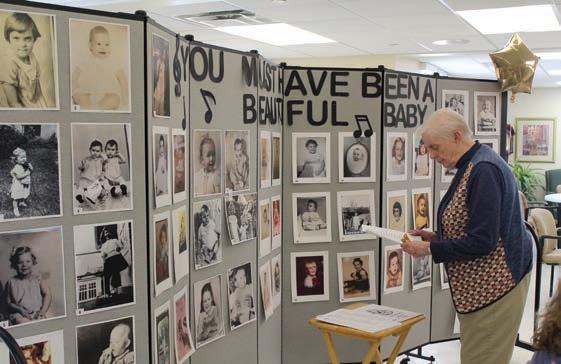
Sisters
